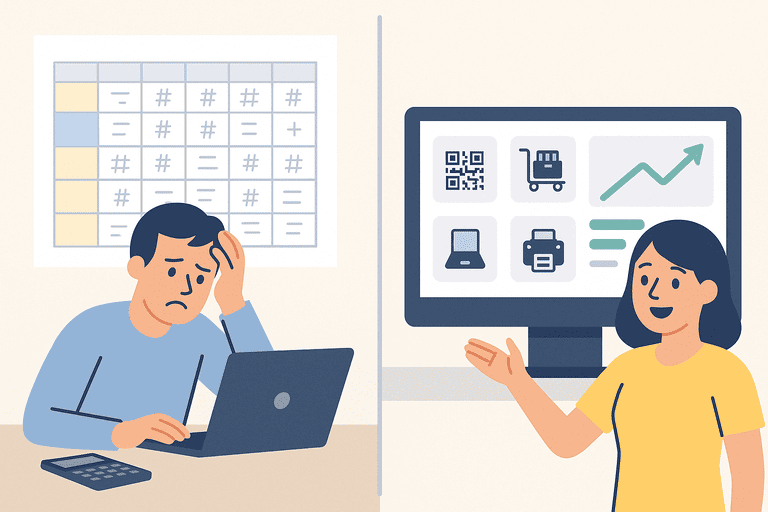From Spreadsheets to Smart Assets: Real-World Digital Transformations
See how teams evolve from messy spreadsheets to smart, connected asset tracking — with real examples of digital transformation success.

Introduction
If your inventory still lives in a spreadsheet, you’re not alone.
Most organizations start there — it’s free, flexible, and easy to share.
But as the team grows, so do the headaches:
- Duplicate entries
- Missing data
- Out-of-date ownership records
- Confusion over what’s real
The next stage of digital maturity is smart asset tracking — automated, connected, and insight-driven.
Let’s explore how real-world teams make the leap from spreadsheets to smart systems.
1. The Limits of Spreadsheets in 2025
Spreadsheets break when:
- More than one person edits them simultaneously
- Data accuracy relies on manual updates
- There’s no history of who changed what
- Photos, documents, or QR codes don’t fit neatly into cells
In short, spreadsheets can store data — but they can’t manage assets.
That’s why growing companies eventually hit a wall: too many users, too many items, not enough control.
2. What “Smart Assets” Really Mean
“Smart” doesn’t mean expensive or complicated.
It means data that is:
- Live: updates in real time
- Linked: connected to users, locations, and sessions
- Verified: changes logged and auditable
- Actionable: analytics guide decisions, not just record them
With InvyMate, a laptop isn’t just a row in Excel — it’s a live entity with a QR code, owner history, and activity timeline.
3. Case Study #1 — Coworking Space Simplifies Shared Equipment
Before:
A coworking space tracked monitors and adapters in a Google Sheet.
Members borrowed items without logging them. Missing gear caused tension.
After switching to smart asset tracking:
- Each item got a QR tag and owner history.
- Members used self-service check-ins via phone.
- Managers saw instant usage reports.
Result:
Missing assets dropped by 80% in two months.
4. Case Study #2 — IT Department Gains Control of 300+ Devices
Before:
The IT lead manually updated a spreadsheet every quarter.
Warranty dates, serials, and assigned users often went out of sync.
After:
- InvyMate linked devices to user profiles and purchase invoices.
- Automated reminders triggered before warranty expiry.
- Asset audit time fell from 3 days to 3 hours.
5. Case Study #3 — Nonprofit Boosts Donor Confidence
Before:
Donated tablets and projectors were scattered across multiple project sites.
Donors asked for proof of usage, but reporting was manual and unreliable.
After:
- Every device was scanned weekly via QR codes.
- Central dashboard generated usage reports automatically.
- The organization included verified data in annual impact reports.
Transparency improved donor retention — and audit stress vanished.
6. Steps to Move from Spreadsheet to Smart System
- Clean your current data — remove duplicates and assign owners.
- Choose an accessible tool — cloud-based, with mobile scanning.
- Import and tag assets — use QR codes or NFC labels.
- Set basic policies — who can create, update, or delete records.
- Train your team — show how easy scanning replaces manual typing.
- Automate reports — monthly summaries sent to managers and finance.
Digital transformation isn’t overnight — it’s incremental and measurable.
7. Measuring the ROI of Going Digital
| Metric | Before | After |
|---|---|---|
| Missing asset reports | Frequent | Rare |
| Audit time | 2–5 days | 2–3 hours |
| User accountability | Low | High |
| Real-time visibility | No | Yes |
Average ROI: 300–400% within the first year, mostly from reduced losses and saved labor.
Conclusion
Transitioning from spreadsheets to smart asset systems is the clearest path to operational maturity.
You don’t just get better data — you unlock real collaboration, accountability, and trust across your team.
The sooner you start tracking smartly, the sooner your assets start working smarter for you.
👉 Ready to upgrade from spreadsheets?
Start your transformation today with InvyMate — the smart way to track, manage, and share every asset.